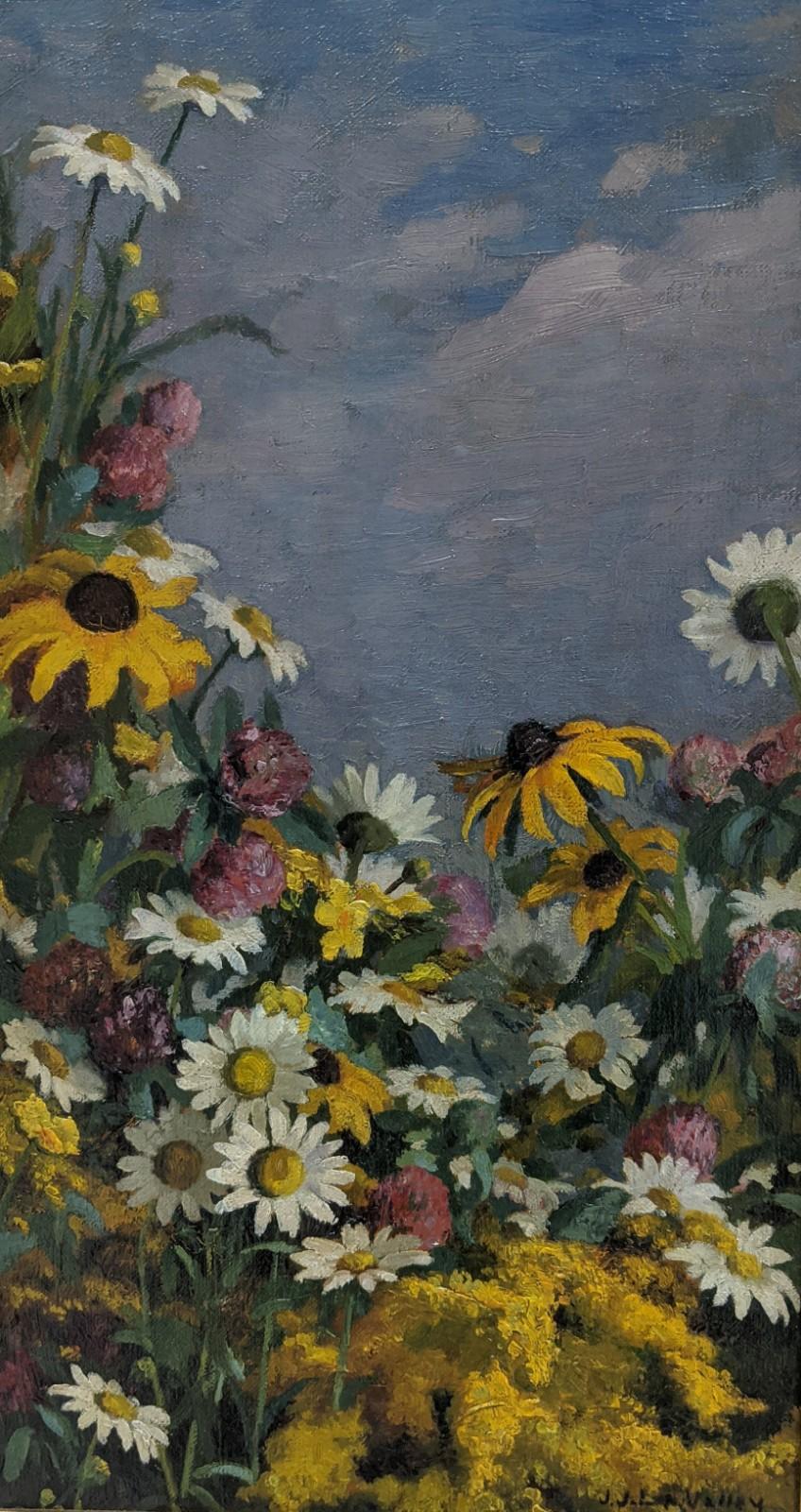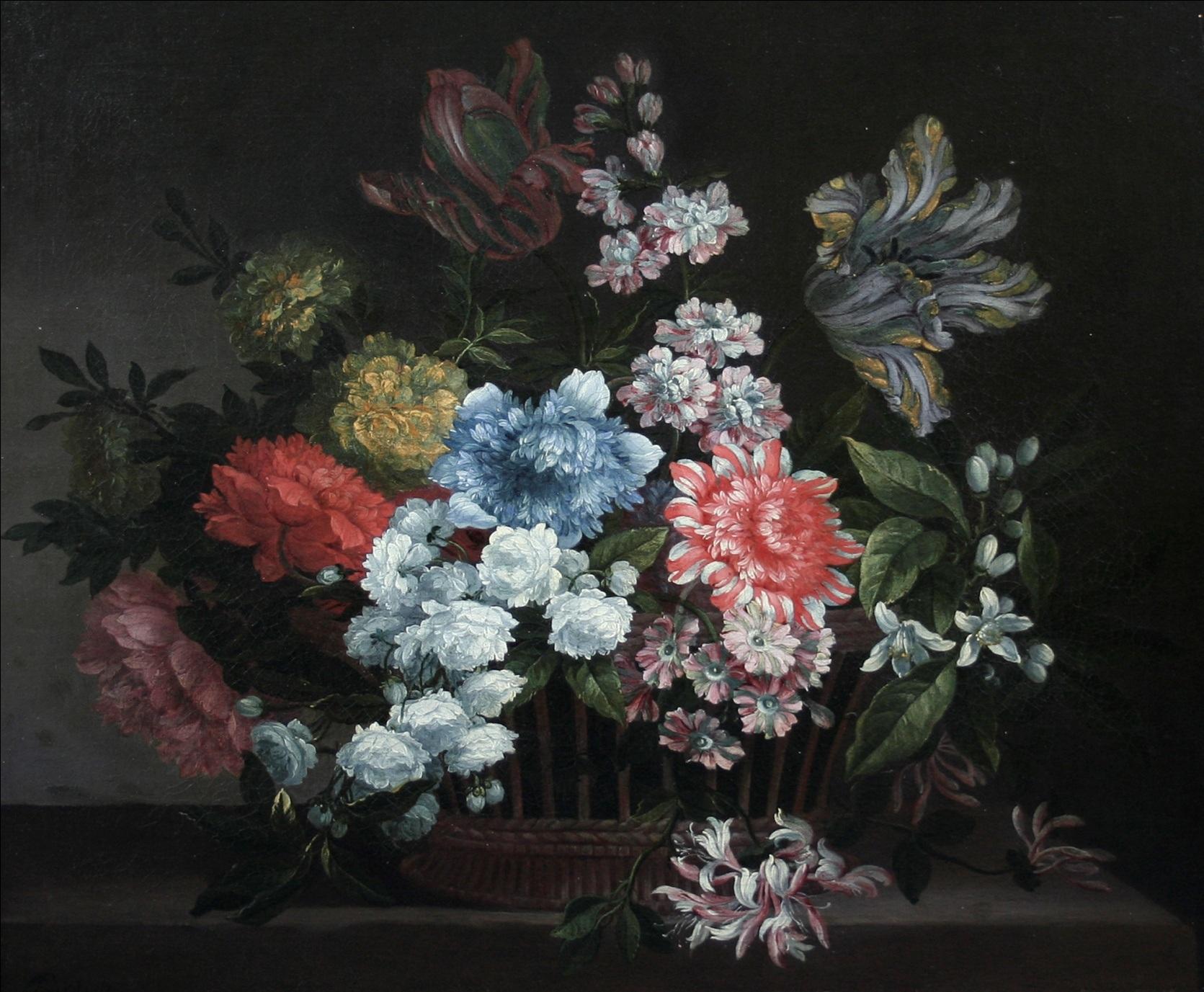Items Similar to Natura morta con frutti, verdure e vaso con fiori su un ripiano in pietra
Want more images or videos?
Request additional images or videos from the seller
1 of 22
UnknownNatura morta con frutti, verdure e vaso con fiori su un ripiano in pietra Primo quarto XVII secolo
Primo quarto XVII secolo
About the Item
Artista attivo in ambito lombardo nel primo quarto del XVII secolo
Natura morta con frutti, verdure e vaso con fiori su un ripiano in pietra
Olio su tela cm. 115 x 170
Studio del Dr. Gianluca Bocchi
La grande Natura morta con frutti, verdure e vaso con fiori su un ripiano in pietra qui presentata è un’opera inedita da ascrivere alla corrente del naturalismo lombardo del primo quarto del XVII secolo, con particolare riferimento all’area compresa fra Cremona e Milano.
Si tratta dell’ambito geografico dove Vincenzo Campi aveva concepito sul finire del Cinquecento le sue ben note scenografie con i venditori e le venditrici di frutti, pollame, pesci e altro. Questi quadri basati sui mestieri e sulla narrazione popolare di gusto fiammingo furono ben presto soppiantati da altri concepiti senza l’intervento di figure umane, più specificamente aderenti alla natura in posa.
Mentre a Milano, all’inizio del XVII secolo, comparvero e riscossero notevole successo piccole ed eleganti composizioni di frutti presentate su alzatine metalliche e all’interno di crespine di ceramica affidate agli abili pennelli prima di Fede Galizia e poi di Panfilo Nuvolone, nel resto della pianura padana e principalmente in ambito cremonese, pittori meno noti continuarono a disporre frutti, verdure e fiori alla maniera di Vincenzo Campi, a singoli gruppi omogenei o miscelati fra loro su ripiani di pietra e su tavoli di legno. Abbiamo numerosi esempi di questi piccoli dipinti con gli elementi raffigurati in verticale, con una presa visuale dall’alto verso il basso secondo una prospettiva poco rigorosa.
In anni passati la letteratura ha sempre inquadrato tali piccole composizioni dall’aspetto quasi metafisico nell’ambito della scuola di Vincenzo Campi, arrivando in taluni casi ad accreditarli addirittura allo stesso Vincenzo. Si è trattato di approssimazioni indotte dalla carenza di informazioni sull’esistenza di altri personaggi poco o per nulla conosciuti e sul genere di raffigurazioni alle quali si applicarono.
Per rimanere in ambito cremonese, un artista da indagare più approfonditamente sarebbe certamente Pietro Martire Alberti, del quale abbiamo notizie certe sino all’anno 1631. Di questo pittore conosciamo due dipinti conservati al Museo Civico Ala Ponzone molto diversi fra loro, uno firmato raffigurante Mazzo di rape, cardo, radici e aglio, l’altro Rinfrescatoio di rame con bottiglia di vino, grappolo d’uva e biscotti (G. Bocchi-U. Bocchi, Naturaliter. Nuovi contributi alla natura morta in Italia settentrionale e Toscana tra XVII e XVIII secolo, Calenzano 1998, pp. 56-57, figg. 43-44). La ricostruzione della sua produzione artistica è stata affrontata negli ultimi anni con il recupero di altri dipinti ma non è ancora stata ufficializzata in una pubblicazione.
L’illustrazione di questi dipinti spiega bene l’attitudine dei loro autori a lavorare in piccolo e giustifica una realizzazione di scenografie più grandi, sul modello di quella qui presentata, mediante l’accostamento di gruppi omogenei di frutti e di verdure, quasi sempre senza sovrapposizioni visive, segno di un arcaismo compositivo tipico della scuola lombarda di inizio secolo. Sono ambientazioni di fantasia dominate da un preciso rigore illustrativo, alle quali i fondali neutri donano, come già detto, un’aura quasi metafisica, aliena da intenti decorativi.
- Creation Year:Primo quarto XVII secolo
- Dimensions:Height: 46.86 in (119 cm)Width: 66.93 in (170 cm)
- Medium:
- Period:Early 17th Century
- Condition:
- Gallery Location:Como, IT
- Reference Number:1stDibs: LU2536212598782
About the Seller
5.0
Vetted Seller
These experienced sellers undergo a comprehensive evaluation by our team of in-house experts.
Established in 1993
1stDibs seller since 2023
- ShippingRetrieving quote...Ships From: Como, Italy
- Return PolicyA return for this item may be initiated within 14 days of delivery.
More From This SellerView All
- Ettore Cosomati (1871-1960) Still life of Marigolds with lemons and pipeLocated in Como, ITEttore Cosomati (Naples 1871 - Milan 1960) Still life of Marigolds with lemons and pipe Oil on canvas in gilded frame Size: 53 x 45 cm (73 x 64 cm including frame) Epoch: the paint...Category
Early 20th Century Still-life Paintings
MaterialsCanvas, Oil
- Still life with flowers, fruits, historiated vases, a parrot and a monkeyLocated in Como, ITNORTHERN ARTIST ACTIVE IN ROME IN THE LAST QUARTER OF THE XVII CENTURY Still life with flowers, fruits, historiated vases, a parrot and a monkey The painting is part of a pair: th...Category
17th Century Still-life Paintings
MaterialsCanvas, Oil
- Still life with vase of flowers, fruits and architectural ruinsLocated in Como, ITNORTHERN ARTIST ACTIVE IN ROME IN THE LAST QUARTER OF THE XVII CENTURY Still life with vase of flowers, fruits and architectural ruins The painting is part of a pair: the twin can...Category
17th Century Still-life Paintings
MaterialsCanvas, Oil
- Portrait of a MusketeerLocated in Como, ITTITO CONTI (Florence 1842 - 1924) Portrait of a Musketeer Oil on canvas in gilded frame Signed in the upper right Canvas measures 40x30 cm (51x43 cm includ...Category
19th Century Figurative Paintings
MaterialsCanvas, Oil
- Saint Francis of Assisi comforted by an angelLocated in Como, ITGuglielmo Caccia said the Moncalvo (Montabone, 1568 - Moncalvo, 1625) Saint Francis of Assisi comforted by an angel Oil on canvas, cm 96 x 73 - (wi...Category
Early 17th Century Old Masters Figurative Paintings
MaterialsCanvas, Oil
- Grazing HorseLocated in Como, ITRuggero Panerai (Firenze 1862-1923) Grazing horse Oil on canvas in gilded frame Canvas size 100x70 cm (116x86 cm with frame) Signed at the bottom left Last quarter 19th century Ruggero Panerai was born in Florence on 13 March 1862. He was employed as a carpenter until the age of fifteen and then studied at the Academy of Fine Arts in Florence, which he attended from 1877 to 1881. His teacher was Giovanni Fattori, who introduced him to the naturalistic painting of landscapes of the Tuscan Maremma and considered him among his most deserving students. Factors' teachings were decisive in orienting the young artist, who adopted the themes and the pictorial technique, updating them with the naturalism flowered in Tuscany through the example of Luigi and Francesco Gioli, Tommasi and Egisto Ferroni. In 1883 he exhibited at the Promotrice in Florence, his impressionism was inspired by the works of Guido Carocci. His painting is also affected by the bourgeois and worldly look of Giuseppe De Nittis and the manner of Vittorio Matteo Corcos who for some years lived in Paris but who returned to Livorno from time to time. Useful for a contact with the Parisian culture could also have been, for Panerai, the proximity with Francesco and Luigi Gioli, who in 1878 went to the French capital, where they had frequented Federico Zandomeneghi. Panerai was also attracted by the military theme. Military subjects are in fact among the most practiced and loved by the artist, who declines them in numerous variations, mostly devoid of pathos, but adhering to a quiet image. In 1887 his painting "Il Guado", presented in Venice, was chosen for the National Gallery of Modern and Contemporary Art in Rome, but instead entered the "Pisani" Gallery. In the same year he exhibited in Genoa, Florence and Milan, where he won the Fumagalli Prize with "Il cavallo malato" (Florence, Galleria d'arte moderna of Palazzo Pitti), a painting in which his qualities as a sensitive animalist painter stand...Category
19th Century Animal Paintings
MaterialsCanvas, Oil
You May Also Like
- Still Life with Squash, Gourds, Stoneware, and a Basket with Fruit and CheeseLocated in New York, NYProvenance: Selma Herringman, New York, ca. 1955-2013; thence by descent to: Private Collection, New York, 2013-2020 This seventeenth century Spanish still-life of a laden table, known as a bodegón, stands out for its dramatic lighting and for the detailed description of each object. The artist’s confident use of chiaroscuro enables the sliced-open squash in the left foreground to appear as if emerging out of the darkness and projecting towards the viewer. The light source emanates from the upper left, illuminating the array, and its strength is made apparent by the reflections on the pitcher, pot, and the fruit in the basket. Visible brush strokes accentuate the vegetables’ rough surfaces and delicate interiors. Although the painter of this striking work remains unknown, it is a characteristic example of the pioneering Spanish still-lifes of the baroque period, which brought inanimate objects alive on canvas. In our painting, the knife and the large yellow squash boldly protrude off the table. Balancing objects on the edge of a table was a clever way for still-life painters to emphasize the three-dimensionality of the objects depicted, as well a way to lend a sense of drama to an otherwise static image. The knife here teeters on the edge, appearing as if it might fall off the table and out of the painting at any moment. The shape and consistency of the squash at left is brilliantly conveyed through the light brush strokes that define the vegetable’s fleshy and feathery interior. The smaller gourds—gathered together in a pile—are shrouded partly in darkness and stand out for their rugged, bumpy exterior. The stoneware has a brassy glaze, and the earthy tones of the vessels are carefully modulated by their interaction with the light and shadow that falls across them. The artist has cleverly arranged the still-life in a V-shaped composition, with a triangular slice of cheese standing upright, serving as its pinnacle. Independent still-lifes only became an important pictorial genre in the first years of the seventeenth century. In Italy, and particularly through the revolutionary works of Caravaggio, painted objects became carriers of meaning, and their depiction and arrangement the province of serious artistic scrutiny. Caravaggio famously asserted that it was equally difficult to paint a still-life as it was to paint figures, and the elevation of this new art form would have profound consequences to the present day. In Spain Juan Sanchez Cotan...Category
17th Century Old Masters Still-life Paintings
MaterialsCanvas, Oil
- Flores Lilas (Lilacs), still life by Spanish Contemporary Artist Fran MoraBy Fran MoraLocated in Battle, East SussexStrange Tracey are proud to be the exclusive agent for Fran Mora in the United Kingdom. Born in Huelva in the south of Spain in 1979, Mora studied at the School of Fine Arts in Sev...Category
21st Century and Contemporary Contemporary Still-life Paintings
MaterialsCanvas, Oil
- Banjo Player Still Life PaintingBy Jill DavenportLocated in Rio Vista, CAOil on canvas painting by Jill Davenport (American, 20th Century) still life titled "Banjo Player" from the Attic series. Signed and dated on bottom lef...Category
20th Century Expressionist Still-life Paintings
MaterialsOil, Canvas
- Still Life with Onions Oil PaintingLocated in Rio Vista, CAEarly substantial, expressionist abstract still life by Lee Lippman (American 1926-2020). Bursting with color and movement titled "Still life with onions" ...Category
20th Century Expressionist Still-life Paintings
MaterialsCanvas, Oil
- Under Summer SkiesLocated in Greenville, DELaValley is an American artist born in New York in 1858. His style is realism and most of his paintings were either landscapes or still lifes. This perticular painting is an exclent ...Category
19th Century Realist Still-life Paintings
MaterialsCanvas, Oil
- Flowers In A Basket - Original Oil, Still Life, French, Franco-Flemish painterBy Jean-Baptiste MonnoyerLocated in Knowle Lane, CranleighFlowers in A Basket by Jean-Baptiste Monnoyer. A Still Life of flowers in a basket including jasmine, honeysuckle, dahlias, parrot tulips, delphiniums and white carnations.Category
1690s Baroque Still-life Paintings
MaterialsCanvas, Oil





